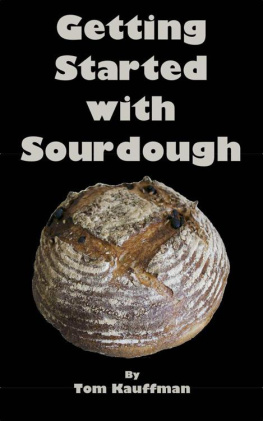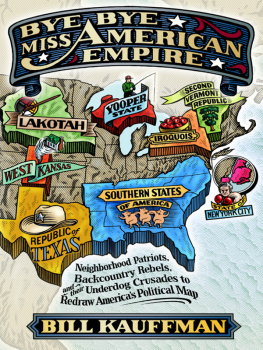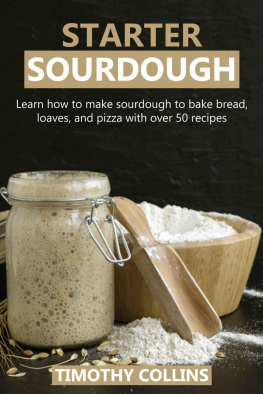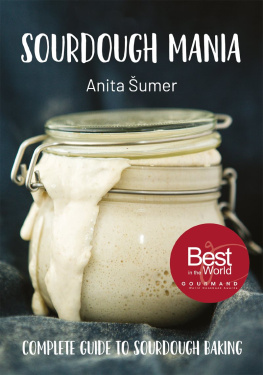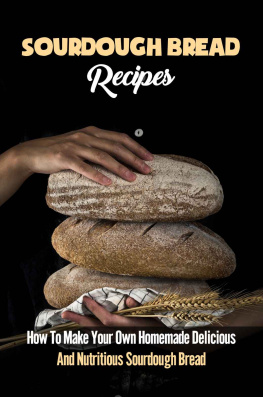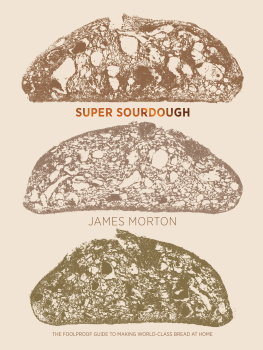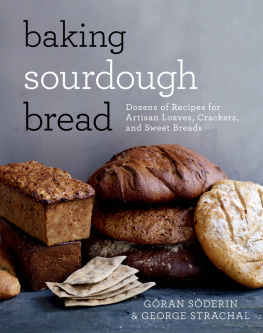Getting Started with Sourdough
Creative Bread Making

by
Tom Kauffman
Text Copyright 2014 Tom Kauffman
All Rights Reserved
Foreword
My husband, Tom Kauffman, is a man of many interests painting, bonsai, photography, cooking. He has even made a violin. Though his interests seem diverse, there is at least one thing they have in common. They each involve a process, and it is in the process that he finds his greatest challenge and joy. Take cheese, for example. When he wanted to make cheese he started by reading everything he could get his hands on about the process. Then he built a cheese press, and then, with a clear sense of the process, he purchased milk from the farmer up the road and began to create delicious cheese.
Over the years he has nurtured an interest in baking bread. Even before we were married he was grinding his own grains and creating healthy breads, an endeavor he thoroughly enjoyed. More recently his interests have turned to sourdough. He has read piles of books, watched hours of videos and experimented with many kinds of sourdough, perfecting his style and producing amazing breads. Most Friday nights over the past months, as Tom has been writing this book, our kitchen has become his bakery, filling our home with warmth and the promise of a small slice of heaven before retiring for the night.
It is with a deep sense of pride that I offer you Toms book of tried and true recipes for sourdough bread, and the simple step-by-step process he articulates. As baking sourdough bread has brought joy to Tom and the many with whom he has shared his loaves, may it do the same for you!
Ginger Kauffman
December, 2014
Table of Contents
- Bread making is an ancient art, for sure, and recipes and techniques abound in printed form and on the internet. It is fascinating to sift through
- The tools I use and recommend are for making bread by hand, one or two loaves
- Yeast is leaven and is known by many names around the world. You might be familiar
- Yeast is everywhere, floating in the air around us. Capturing it and
- This week you will be developing your starter by creating a mix that attracts yeast. When
- You have created your own starter and it has all the building blocks you will need

Creative Bread Making, One Loaf at a Time
Bread making is an ancient art, for sure, and recipes and techniques abound in printed form and on the internet. It is fascinating to sift through them and notice the variety of approaches to the art of bread making. I have two goals in writing this book. First, by compiling and distilling what I have learned from lots of reading and experimenting, I want to take out the mystery and eliminate any confusion concerning the order in which to do things. Second, and more importantly, I want to encourage you to experiment with ingredients. Use what you have at hand fearlessly. Why not use that leftover oatmeal you made for breakfast in your next loaf of bread? Do you want to experiment with spices? Do it!
Variations on the theme of flour, water and salt are nearly infinite. The reward is in the experimentation. My hope is that this book will offer easy-to-follow steps that will make your bread baking enjoyable. Because we will be dealing with sourdough, you will find the overall times to be longer than with yeast breads, but patience is probably already part of your DNA or you wouldnt even be considering sourdough. My day job necessitates fitting bread making in with my work schedule, and it does. I build up the starter throughout the week so that everything is ready to put together when I return from work at 4:00 p.m. Friday afternoon and by 10:00 p.m. the loaf is on the cooling rack. Whenever you decide to bake, I want this book to give you the tools you need to succeed in creating your own sourdough bread.

Equipment
The tools I use and recommend are for making bread by hand, one or two loaves at a time. I make a single loaf and the recipes in this book are for single loaves. Pictured above are the tools you will need, with their description below in clockwise order, starting with the digital scale.
Digital Scale - This is extremely useful for getting consistent baking results. Measuring digitally allows you to get the exact amount the recipe calls for every time. The flour to water ratio when making sourdough bread is critical and a digital scale will give you the confidence that your measurements are correct. In time you will develop the knack for knowing when the dough looks and feels right.
Bowl Scraper - Use this flexible white plastic scraper for mixing and handling the dough.
Pinch Bowls - Handy for measuring out salt and other spices or herbs.
Lame - This bread slashing tool is traditionally used to add the baker's signature to the loaf, in much the same way as an artist would sign a painting. In the past it was especially useful for bakers sharing a communal oven. If you don't have a lame, you can use a sharp knife, razor blade, or even scissors. (Besides adding the bakers signature, slashing the top of the loaf allows the pressure that builds up while it is baking to push the bread up rather than out.)
Bread Peel Seen under the basket and gloves, it is used to transfer the loaf to and from the Dutch oven. You could get away with using a flat cookie sheet for this operation if you dont have a peel.
Proofing Basket - Traditional basket used for the final rise, it gives your bread that beautiful artisan look. It is made with coiled rattan and also goes by other names such as Banneton or Brotform.
Oven Gloves - Be safe! Remember you are handling things in the oven that are as much as 500 degrees Fahrenheit.
6-Quart Mixing Bowl - All mixing is done in this so that your dough seldom needs to touch the counter, saving cleanup and unnecessary handling.
Bowl Cover - Used to cover the bread while it rises in the mixing bowl. It could be a tea towel or plastic wrap or a store bought bowl cover. I find that a shower cap, which I brought home from a bed and breakfast, works really great. It is reusable and fits neatly over the top of the mixing bowl (shown attached to bowl), wicker basket or bread pan.
Cooling Rack - A must for getting your loaf to cool properly.
Double Dutch Oven - This creates a mini-oven in your home kitchen with conditions similar to those found in professional ovens. It holds in the moisture and gives your loaf that desired oven spring. Lodge makes this pre-seasoned cast-iron combo cooker and I love it. But if you already have a Dutch oven then you are all set.
Parchment Paper - Used to line the Dutch oven, it adds control when you are transferring the loaf from the peel to the hot Dutch oven.

Simply Bread, Leaven Creation
Yeast is leaven and is known by many names around the world. You might be familiar with levain, chef, pate fermentee, sponge, madre bianca, biga, mother, poolish, sourdough or starter. There are subtle differences, but the main distinction is that they all use bakers yeast except the sourdough and levain, which only use wild yeast that lives in the air. We need yeast to make dough rise and form a beautiful loaf of bread. Furthermore our starter will need to have a lot of strength to do its job well.
Next page
